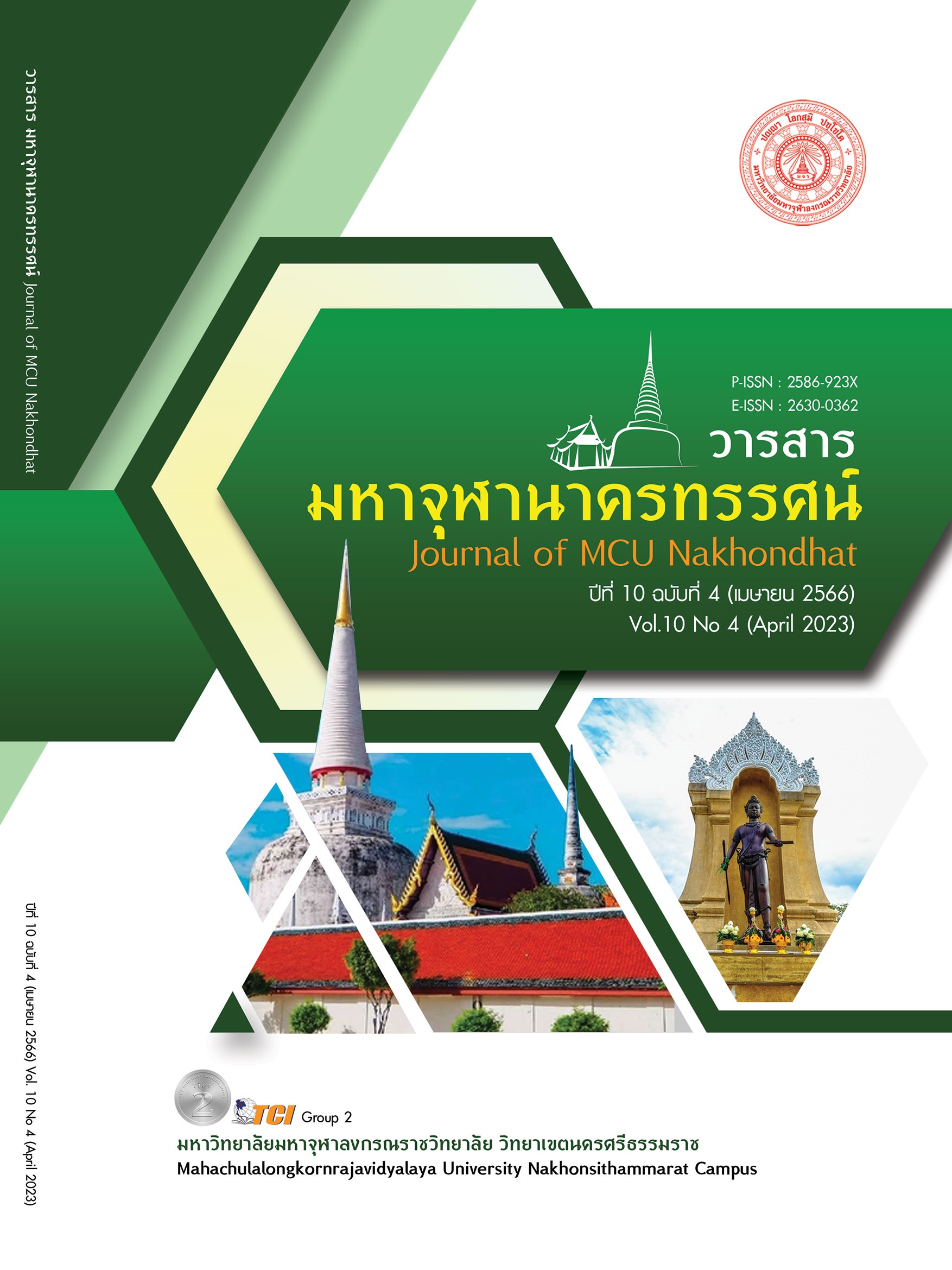FACTORS AFFECTING CRITICAL THINKING STUDENT
Main Article Content
Abstract
This article is an academic article aimed at presenting factors affecting the critical thinking of teachers toward students. Authors synthesize and summarize academic articles from books, documents, textbooks, journals, theses, research papers, and the Internet. can be summarized as follows ; 1) The ability and good relationship of instructors with students was the person who had a good interpersonal relationship between instructors and students from caring and attentive. 2) Reading habit factor. The most important thing to encourage students to develop critical thinking skills. Students must know and use the correct way of reading to practice themselves regularly. Teachers must emphasize the use of teaching methods for students to learn by themselves. This will be a factor conducive to reading to create critical thinking. 3) Factors on learning attitude. Instructors must have preparation for teaching, including media, materials, equipment, documents and activity manuals. and the process of organizing activities was prepared to encourage students to develop critical thinking skills. Highly motivated students are capable of planning, thinking critically in order to achieve the standards of excellence they set. 5) Classroom climate factor. Teachers must provide a classroom atmosphere that is a factor in encouraging students to be motivated, challenged, trusted, fun, and willing to take risks. The classroom atmosphere contributes to and facilitates students to think critically effectively
Article Details

This work is licensed under a Creative Commons Attribution-NonCommercial-NoDerivatives 4.0 International License.
References
เกษตรชัย และหีม. (2550). การพัฒนาการศึกษาของสังคม. สงขลา: มหาวิทยาลัย สงขลานครินทร์.
เข้ม ชอบกิตติ์วรกุล. (2560). การประเมินโครงการส่งเสริมนิสัยรักการอ่านโรงเรียนอมก๋อยวิทยาคม จังหวัดเชียงใหม่. ใน วิทยานิพนธ์ศึกษาศาสตรมหาบัณฑิต สาขาวิชาการบริหารการศึกษา. มหาวิทยาลัยเชียงใหม่.
ชนาธิป พรกุล. (2557). การสอนกระบวนการคิด : ทฤษฎีและการนำไปใช้. กรุงเทพมหานคร: สำนักพิมพ์แห่งจุฬาลงกรณ์มหาวิทยาลัย.
ชัยวัฒน์ สุทธิรัตน์. (2561). การจัดการเรียนการสอนในศตวรรษที่ 21. กรุงเทพมหานคร: วีพรินท์.
ทิศนา แขมมณี. (2551). ทักษะการคิดวิเคราะห์ สังเคราะห์ สร้างสรรค์ และการคิดอย่างมี. วิจารณญาณ : การบูรณาการในการจัดการเรียนรู้. กรุงเทพมหานคร: จุฬาลงกรณ์มหาวิทยาลัย.
บรรจง อมรชีวิน. (2556). การคิดอย่างมีวิจารณญาณ. กรุงเทพมหานคร: ภาพพิมพ์.ปราณี หลำเบ็ญสะ และชิดชนก เชิงเชาว์. (2553). ปัจจัยที่มีอิทธิพลต่อแรงจูงใจใฝ่สัมฤทธิ์ทางการเรียน. สงลขลา: มหาวิทยาลัยสงขลานครินทร์.
ปราณี หลำเบ็ญสะ และชิดชนก เชิงเชาว์. (2553). ปัจจัยที่มีอิทธิพลต่อแรงจูงใจใฝ่สัมฤทธิ์ทางการเรียน. สงลขลา: มหาวิทยาลัยสงขลานครินทร์.
ปัญจนาฏ วรวัฒนชัย. (2560). กลไกสมองสองซีกกับความคิดสร้างสรรค์ของมนุษย์. วารสารสารสนเทศ, 15(2), 1-12.
ปาณิสรา อามะรีณ์. (2561). การพัฒนาความสามารถด้านการคิดอย่างมีวิจารณญาณและผลสัมฤทธิ์ทางการเรียน วิชาชีววิทยา เรื่อง ยีนและโครโมโซมของนักเรียนชั้นมัธยมศึกษาปีที่ 6 โดยการจัดการเรียนรู้รูปแบบซิปปาร่วมกับเทคนิคการใช้คำถาม. กรุงเทพมหานคร: สำนักงานการวิจัยแห่งชาติ (วช.).
ปิยณัฐ อุปแก้ว. (2562). การพัฒนาการจัดการเรียนรู้โดยใช้ปัญหาเป็นฐานเพื่อส่งเสริมการคิดอย่างมีวิจารณญาณ เรื่อง ความปลอดภัยในชีวิตกลุ่มสาระการเรียนรู้สุขศึกษาและพลศึกษาชั้นมัธยมศึกษาปีที่ 5. ใน วิทยานิพนธ์ปริญญาศึกษาศาสตร์มหาบัณฑิต สาขาวิชาการบริหารการศึกษา บัณฑิตวิทยาลัย. มหาวิทยาลัยราชภัฏชัยภูมิ.
พัศรินท์ ก่อเลิศวรพงศ์. (2559). จิตวิทยาการศึกษา · การเรียนรู้ (จิตวิทยา). กรุงเทพมหานคร: มหาวิทยาลัยสวยดุสิต.
พินิจ อุไรรักษ์. (2553). ผลการใช้รูปแบบการจัดกิจกรรมพัฒนาผู้เรียนโดยใช้กระบวนการวิจัยที่มีต่อการคิดอย่างมีวิจารณญาณ การไฝ่รู้และเจตคติต่อกิจกรรมพัฒนาผู้เรียนและเจตคติต่อกิจกรรมพัฒนาผู้เรียน. เรียกใช้เมื่อ 20 มกราคม 2565 จาก https://dric.nrct.go.th/
ว.วชิรเมธี. (2552). งานสัมฤทธิ์ชีวิตรื่นรมย์. กรุงเทพมหานคร: ปราณพับลิชชิ่ง.
วรากรณ์ สามโกเศศ. (2554). โลกนี้ไม่มีอะไรฟรี 5 ถูกสุดคือแพงสุด. กรุงเทพมหานคร: มติชน.
วราภรณ์ ภิรมย์นาค. (2559). การประเมินผลโครงการส่งเสริมนิสัยรักการอ่าน. บุรีรัมย์: มหาวิทยาลัยราชภัฏบุรีรัมย์.
วาริน เชิญกลาง. (2557). การส่งเสริมนิสัยรักการอ่านตามความคิดเห็นของผู้บริหารและครูสังกัดสานักงานเขตพื้นที่การศึกษาประถมศึกษาสระบุรี. วารสารวิจัยและพัฒนาวไลยอลงกรณ์ในพระบรมราชูปถัมภ์, 11(1), 81-90.
วิชชุดา เตียวกุล. (2559). การใช้กิจกรรมแนะแนวกลุ่มต่อลักษณะนิสัยในการเรียนและเจตคติต่อการเรียน. กรุงเทพมหานคร: จุฬาลงกรณ์มหาวิทยาลัย.
สำนักวิชาการและมาตรฐานการศึกษา. (2555). การสอนทักษะการคิดแบบมีวิจารณญาณ. กรุงเทพมหานคร: สำนักวิชาการและมาตรฐานการศึกษา.
สุคนธ์ สินธพานนท์ และคณะ. (2555). ทักษะการคิดตามแนวปฏิรูปการศึกษา. กรุงเทพมหานคร: เทคนิคพริ้นติ้ง.
สุจิตรา จรจิตร. (2556). ปัจจัยที่มีอิทธิพลต่อประสิทธิผลของการบริหารสถานศึกษา. สกลนคร: มหาวิทยาลัยราชภัฏสกลนคร.
สุชาติ วัฒนชัย และคณะ. (2561). การออกแบบนวัตกรรมการเรียนรู้ที่ส่งเสริมการคิด. ขอนแก่น : มหาวิทยาลัยขอนแก่น.
เอมอร เนียมน้อย. (2551). พัฒนาการอ่านอย่างมีวิจารณญาณด้วยวิธี SQ3R. กรุงเทพมหานคร: สุวีริยาสาส์น.
Bloom, B. S. (1976). Human Characteristics and School Learning. New York: McGrawHill.
Christensen, C. M. (1999). human relations between teachers and students. Boston: Irwin/McGraw-Hil.
Ennis, R. H., & Norris, S. (1989). Evaluating critical thinking. Pacific Grove, CA: Midwest Publications.
Hessong, R. F., & weeks, T. H. (1987). Introduction to Education. New York: Macmillan Publishing.
Higuchi, K. A. & Donald, J. G. (2002). Thinking Processes Used by Nurses in Clinical DecisionMaking. Journal of Nursing Education, 41(4), 145-153.
Hudgins, B. (1977). Childen's Self Directed Critical Thinking. Journal of Education Research, 81(5), 262-273.
Jay, McTighe. (1991). Differentiated Instruction and Educational Standards : Is Détente Possible? Retrieved January 20, 2023, from https://www.jstor.org/stable/3497003
Kholoud, A. et al,. (2010). Synthesis and applications of silver nanoparticles. Boston: Irwin/McGraw-Hil.
McClelland, D.C & Nicholl,A. (2008). This then poses the question of how best to theorise the idea. Cambridge: Cambridge University Press.
McClelland, D. C. (1953). The Achievement Society. New York: The Free Press.
McClelland, D.C. (1985). Human motivation. Cambridge: Cambridge University Press.
Rogers, Carl R. . (1990). Freedom to Learn . Ohio. Charles E: Meril.
Shapiro, L.E. (1993). How to Raise a Child with a High EQ : A Parents’ Guide to EmotionalIntelligence. New York: Harper Collins.
Sizer,T & Dean, J. (1998). Factors affecting thinking. Boston: Irwin/McGraw-Hil.
Watson , G. & Glaser , E.M. (1964). Watson Glaser Critical Thinking AppraisalManual. New York: Harcourt , Brace and World Inc.
Yang, H. (2002). thinking. Retrieved January 20, 2023, from http://webcache.googleusercontent.com/


